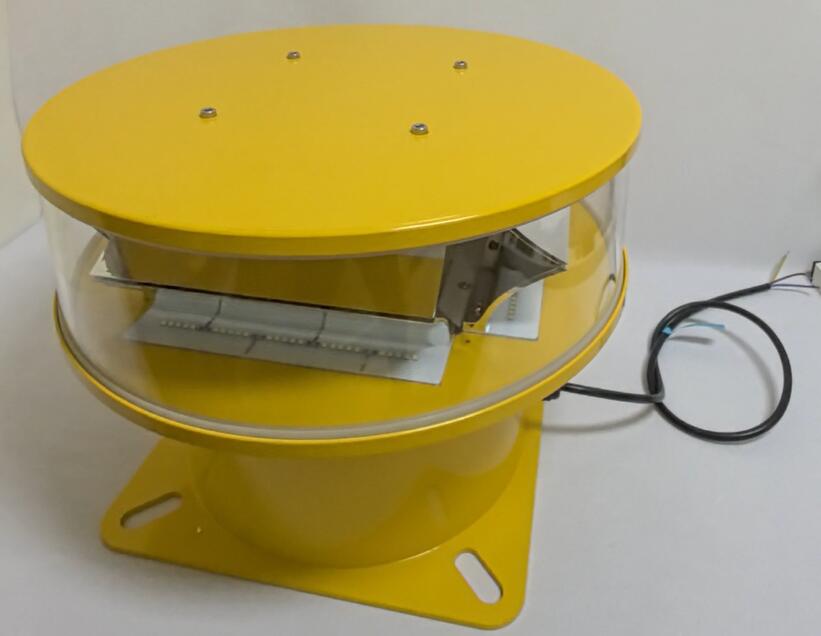LED Aviation Obstruction Light: Revolutionizing Airspace Safety with Smart Illumination
The aviation industry's shift toward sustainable, high-performance solutions has propelled LED aviation obstruction light systems to the forefront of aerial safety technology. These advanced lighting systems combine energy efficiency with superior visibility, redefining how we protect both aircraft and tall structures in an increasingly crowded airspace. This article examines the technical breakthroughs, regulatory standards, and operational advantages that make LED systems the gold standard in obstruction lighting.
The LED Advantage in Aviation Lighting
Modern LED systems outperform traditional lighting in five key areas:
Energy Efficiency
80% less power consumption than incandescent systems
Typical power draw: 15-50W vs. 100-500W for conventional lights
Enables solar-powered operation in remote locations

Operational Longevity
50,000-100,000 hour lifespan (5-10 years continuous use)
10x longer service life than halogen alternatives
| led aviation obstruction light |
Minimal lumen depreciation over time
Enhanced Visibility
Precise light spectrum targeting (620nm red/5500K white)
| led aviation obstruction lights |
Instant full-intensity illumination (no warm-up period)
Customizable flash patterns (40-60 fpm standard)
Environmental Resilience
-40°C to +70°C operational range
IP66/68 waterproof ratings for marine environments
UV-resistant polycarbonate lenses
Smart Integration
IoT-enabled performance monitoring
Automatic brightness adjustment (day/night/weather)
Remote configuration and diagnostics
Regulatory Compliance Framework
LED obstruction lights meet all major aviation standards:
Standard Requirement LED Solution
FAA AC 150/5345-43 Intensity levels Programmable drivers
ICAO Annex 14 Color chromaticity Precision-tuned LEDs
EN 61820 Flash patterns Microcontroller control
CASA MOS 139 Durability Military-grade materials
Technical Implementation Considerations
Optical Design Innovations:
Total internal reflection (TIR) lenses for 360° coverage
Asymmetric beam shaping for structure-specific patterns
Glare reduction through precision optics
Thermal Management:
Aluminum heat sinks with graphene coatings
Passive convection cooling designs
Temperature-regulated driver circuits
Power Systems:
Universal 90-305VAC input
DC backup battery systems
Hybrid solar/wind charging options
Case Study: Empire State Building Retrofit
The 2018 LED upgrade achieved:
82% energy reduction (from 58kW to 10.5kW)
30% increase in visibility range
Predictive maintenance through IoT sensors
Customizable color schemes for special events
Emerging Technologies
Next-Gen Developments:
LiFi-enabled lights for data transmission
Self-powered piezoelectric systems
AI-driven predictive failure analysis
Nanophotonic light guides for ultra-directional beams
Installation Best Practices
Structural Integration:
Finite element analysis for wind loading
Electromagnetic interference shielding
Lightning protection systems
Maintenance Protocols:
Drone-assisted inspections
Modular component replacement
Annual photometric verification
Global Market Analysis
Leading Manufacturers: REVON LIGHTING
Projected Growth:
12.7% CAGR through 2029
$287M market by 2026
Asia-Pacific fastest growing region
Cost-Benefit Perspective
Financial Analysis (10-Year Horizon):
60-75% lower operating costs
90% reduction in maintenance
ROI within 2-3 years for most installations
The transition to LED aviation obstruction light systems represents more than just an equipment upgrade—it signifies a fundamental shift in how we approach aerial safety. These intelligent lighting solutions deliver unprecedented reliability while addressing the aviation industry's sustainability goals. As urban density increases and airspace becomes more congested, LED technology provides the flexibility, efficiency, and smart capabilities needed for future-proof obstruction lighting.
For airport authorities, tower operators, and urban planners, adopting LED systems is no longer merely an option but a critical safety imperative. The continued evolution of this technology promises even greater integration with air traffic management systems, potentially transforming passive warning lights into active participants in collision avoidance networks. In the quest for safer skies, LED aviation obstruction lights are illuminating the path forward.
